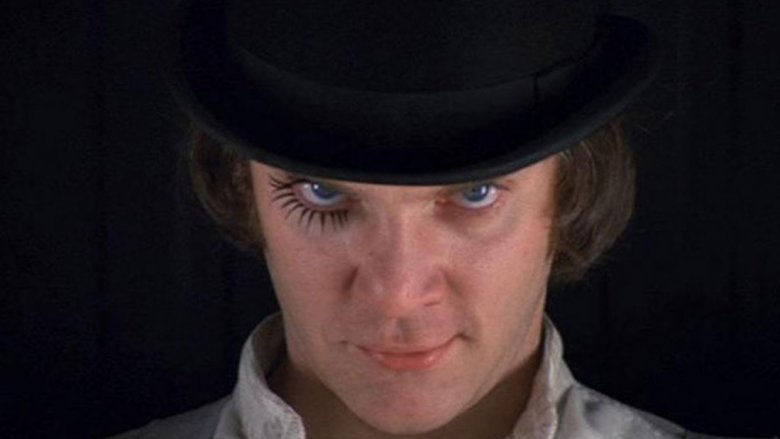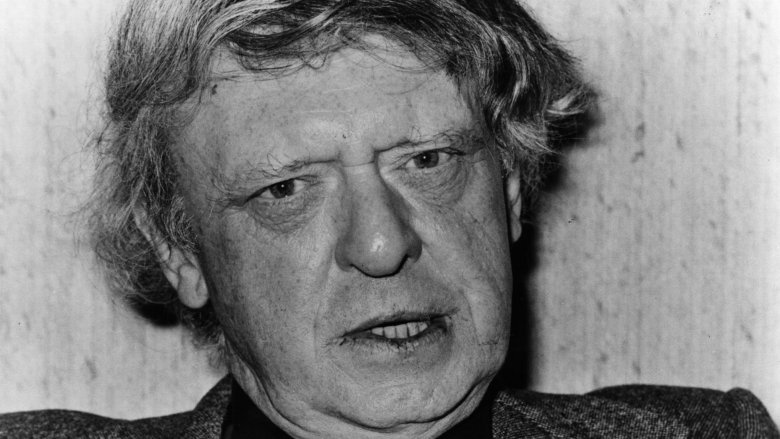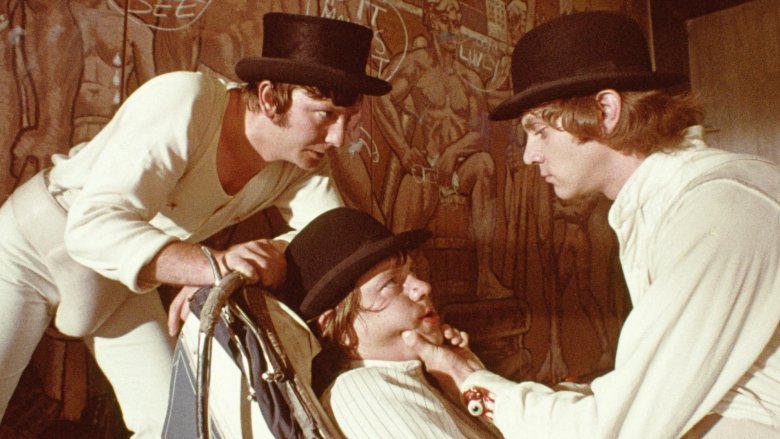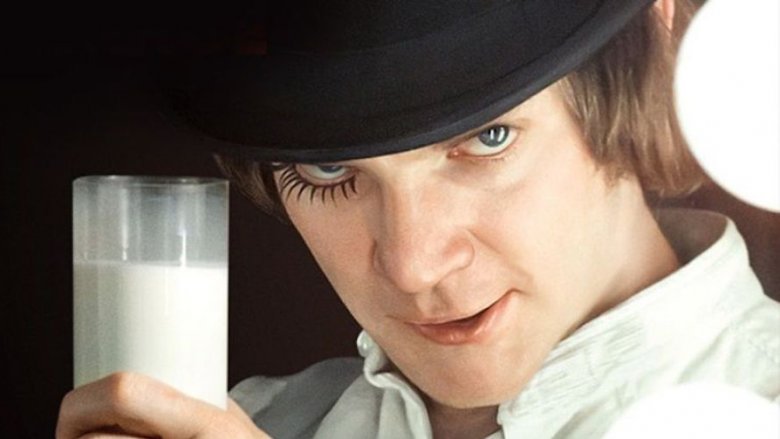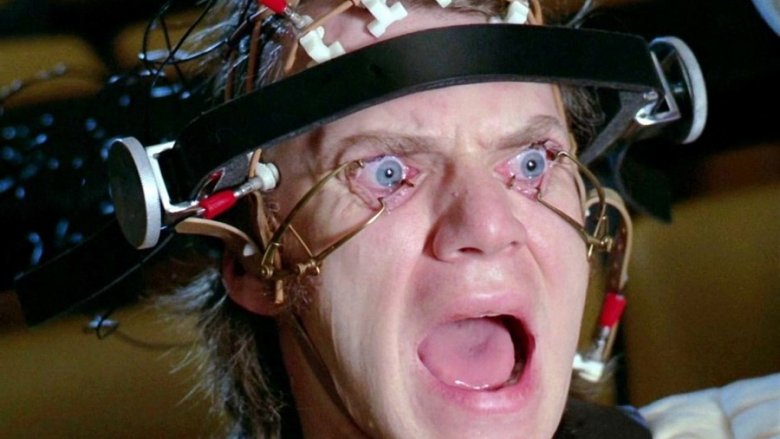The Truth Behind The Clockwork Orange Sequel
Released way back in 1971, A Clockwork Orange remains one of the most controversial films ever made. Set in a London of the future, it follows Alex DeLarge (Malcolm McDowell) and his gang of criminal "droogs" as they get high on drug-laced milk and indulge in "a bit of the ultra-violence." Then, Alex gets caught and becomes a test subject for aversion therapy, leading to one of the film's most famous sequences: Alex being re-sensitized to violence by being forced to watch disturbingly savage materials. Based on English author Anthony Burgess' 1962 novel, it's a shocking, dystopian look at the social effects of violence and a warning about encroaching fascism.
A Clockwork Orange was a box office hit and earned four Academy Award nominations, including Best Director for the legendary Stanley Kubrick, and one for Best Picture. It's also one of the few successful movies to never get a sequel. But some newly publicized documents from Burgess show that the story and characters of A Clockwork Orange remained in his mind for years.
It's in a certain "Condition"
There exists a follow-up to A Clockwork Orange. This isn't a rough cut of some long-lost, completed film in which Malcolm McDowell reprises his role as Alex DeLarge. Nor is it a screenplay for a heretofore un-produced sequel to that 1971 cult classic movie. And it's not even a continuation of Anthony Burgess' creepy science-fiction novel. The Clockwork Condition is actually a collection of non-fiction essays that Burgess wrote about the public and critical response to A Clockwork Orange. And, at that, it's more about the movie adaptation written and directed by Stanley Kubrick, with which Burgess had little involvement.
According to the BBC, it's a "collection of Burgess' thoughts on the human condition and develops the themes" from his original book, or, in the author's words, "part philosophical reflection and part autobiography." The Clockwork Condition is a meditation from Burgess about the effects film and television could have on humanity. So while it's not a true narrative sequel, it's certainly a one-of-a-kind piece, and a major lost work by one of the 20th century's most important and future-focused writers.
Where was it hiding all these years?
It's astonishing how a follow-up to a major work of fiction (adapted into a famous movie) by a highly-regarded author could just disappear for decades, but that's the fate of The Clockwork Condition. Anthony Burgess lived in Bracciano, Italy, just outside of Rome. He died in 1993, and his house was subsequently sold. His personal papers and writings were then boxed up and shipped off to Manchester, England (Burgess' birthplace), where the International Anthony Burgess Foundation undertook the daunting task of reviewing and cataloging the author's many documents and notes.
Therein, Foundation workers eventually discovered The Clockwork Condition. The newly-discovered work explores Burgess' "views on crime, punishment, and the possible corrupting effects of visual culture," according to Foundation director Andrew Biswell — all themes dramatized in A Clockwork Orange. Biswell said that Burgess abandoned the book when, not pleased with his results, he realized that he "was a novelist and not a philosopher."
Anthony Burgess didn't finish it
While news of The Clockwork Condition broke around the same time that the Design Museum in London opened "Stanley Kubrick: The Exhibition," a showing of more than 500 objects relating to the work of the director of A Clockwork Orange, the manuscript of Burgess' book isn't yet ready for public consumption.
According to International Anthony Burgess Foundation director Andrew Biswell in The Guardian, the unfinished work totals about 200 pages and comprises a mix of typewritten drafts, notes, outlines, and section concepts. That's way more than Burgess acolytes thought existed. Biswell says that Burgess mentioned The Clockwork Condition just once, in a 1975 interview in which he said the book had only gotten to the "idea" stage.
While he worked more on it than previously thought, it wasn't all that far along; Burgess apparently wanted to collect photographs and quotations to round out the material, but those things never came together. Instead, Burgess explored the philosophical themes of The Clockwork Condition in a 1974 novel called The Clockwork Testament, which, despite the title, is not a successor to A Clockwork Orange.
The truth about "A Clockwork Orange"
So, while The Clockwork Condition doesn't give A Clockwork Orange fans an update on what ultimately happened to Alex DeLarge and his droogs, it does answer one of the most enduring mysteries about both film and novel. Not until the unveiling of Condition did Burgess ever definitively explain the meaning of the title "A Clockwork Orange." Sure, it's got that spooky, vaguely unsettling, futuristic vibe that suggests some combination of humans being unable to change (clockwork) and weirdness (the color orange and its un-rhymability make it unique), both major themes in the novel. It's not random, though.
Burgess heard an old man use the phrase in a bar once, and it fascinated him. "In 1945, back from the army," Burgess writes in The Clockwork Condition, "I heard an 80-year-old Cockney in a London pub say that somebody was 'as queer as a clockwork orange,'" with "queer" understood to mean "crazy" and not "homosexual." Burgess explained that for almost two decades he "wanted to use it as the title of something" because it was so "traditional" sounding, and he used it for his novel about Alex and the gang because it suitably "combined a concern with tradition and a bizarre technique."
